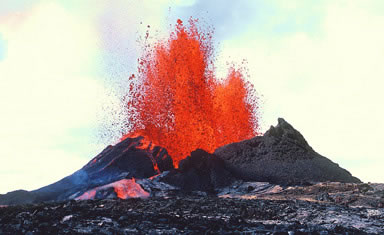Saturday, May 14, 2005
Hawaiian volcanoes not monitored properly

Mauna Loa and Kilauea are two active volcanoes that are currently threatening to erupt and cause earthquakes and tsunamis.

When Mount St. Helens began erupting a quarter century ago, it was news to much of the country that the United States had volcanoes, at least outside Hawaii. No wonder. There hadn't been an eruption in the continental 48 states since a series of spectacular explosions at California's Mount Lassen between 1914 and 1917.
Today, as St. Helens rumbles along, the state of knowledge about volcanoes remains inadequate, even among the officials charged with alerting the public to threats. Preventing losses of life or property would require completion of a strong national early warning system along lines the U.S. Geological Survey has been examining.
A USGS report last month warned that many of the most dangerous volcanoes, including some in the Cascade Range from Washington to California, have inadequate warning systems. Among 18 very high-threat peaks nationally, the report says four are in Washington: St. Helens, Rainier, Baker and Glacier Peak. Mount Adams falls in the next highest risk category. All five peaks should have detailed monitoring, but only St. Helens' current system is given good marks.
And even the monitoring at St. Helens needs improvements. For Glacier Peak, which is in eastern Snohomish County, the report shows a particularly large discrepancy between its current minimal monitoring and what it should have.
The USGS partly based its calculations of threat levels in part on proximity to population centers. Mount Rainier's threat, for instance, has led to extensive disaster planning efforts in Pierce County, where it is possible an eruption could affect the entire population. Mudflows are the biggest potential problem, particularly in urbanized valleys such as the Puyallup.
The report also warns that many remote volcanoes in Alaska need better monitoring to reduce the danger of a catastrophic loss of a crowded airliner. In December 1989, ash from Redoubt Volcano disrupted holiday travel between Seattle and Anchorage and nearly brought down a crowded KLM Royal Dutch Airlines Boeing 747 airliner flying to Tokyo.
Some of the other major threats are also in the United States' most scenic areas. Hawaii has one currently erupting volcano, Kilauea, and Mauna Loa is exhibiting heightened unrest. USGS describes the United States' premier national park, Yellowstone, as an "undermonitored high-threat caldera system."
Life around the Pacific's Ring of Fire carries risks of earthquakes, volcanic eruptions and tsunamis. Members of Congress and President Bush have properly responded to the South Asian tsunamis with plans for increased monitoring both internationally and along U.S. coasts. Similar vigilance is needed with volcanoes.
On Wednesday, the Northwest will mark the 25th anniversary of the 1980 St. Helens' eruption that claimed dozens of lives. As the USGS notes, the scientific ability to forecast eruptions has increased dramatically. We ought to use those advances to build a monitoring system for all the volcanoes that pose the highest risks to people.